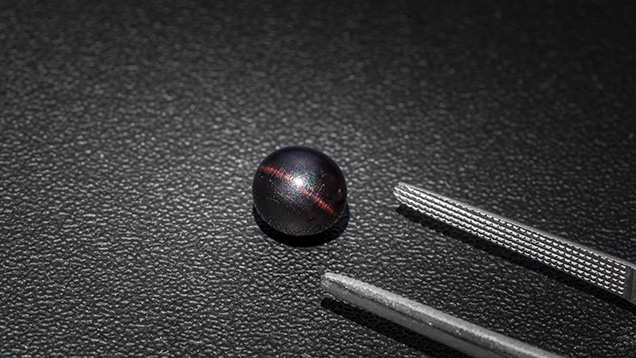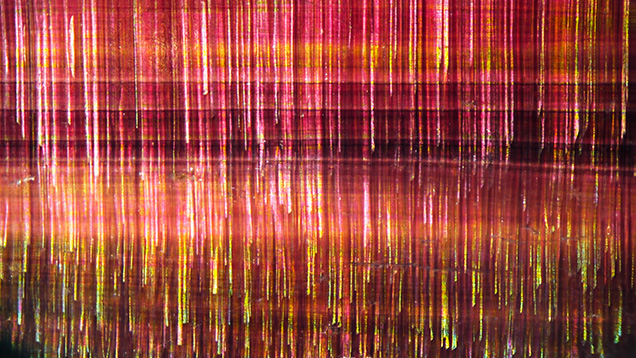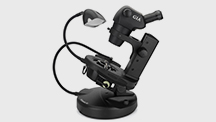Imitation Cat’s-Eye Pen “Pearls”

Chatoyancy is an optical phenomenon commonly seen in gemstones that have an abundance of parallel solid or hollow long acicular inclusions in which an eye-like band is produced when viewed in strong light. Fine cat’s-eye gemstones of various mineral species are prized; however, natural chatoyancy in pen pearls would be an extraordinary occurrence. During a recent study on reportedly non-nacreous pearls from the Dr. Eduard J. Gübelin Collection, the author found three dark brown button-shaped samples stated to be from a Pinna species mollusk. All three samples displayed an attractive cat’s-eye effect when illuminated under a fiber-optic light or any single white light (figure 1). In each specimen, the chatoyant band manifested as a single bright pink line extending across the surface in a direction perpendicular to the internal fibrous structure.
Evidence of human manipulation includes fine linear features present in random directions across cellular structures; these are proof of work carried out during the fashioning of the samples into cabochons. Microscopic examination revealed the fibrous structure as numerous well-formed, minute parallel acicular crystals. Infrared spectroscopy subsequently confirmed the crystals to be calcite. The calcite was arranged in a vertical columnar orientation rather than in a radial and concentric structure characteristic of non-nacreous Pinna (pen) pearls, which led to further doubts concerning the “pearl” identity of the samples.
Microradiography of all three samples revealed tight internal structures. The obvious radial structures that would be expected in pen pearls were not observed (N. Sturman et al., “Observations on pearls reportedly from the Pinnidae family (pen pearls),” Fall 2014 G&G, pp. 202–215). Based on its external and internal features, this material was almost certainly the same type of imitation pearl previously reported in G&G (Winter 2011 GNI, pp. 330–332).
Fluorescence images taken of one specimen using a polarizing microscope and an ultraviolet excitation filter with a wavelength range of 330–380 nm (figure 2, left) reveal a prominent banded structure at right angles to the calcite columns. When viewed at right angles to their lengths under the same conditions, the long, thin calcite crystals reveal a hexagonal cross-section, creating a striking mosaic or cellular pattern (figure 2, right). The cells varied in form, and their approximate diameters ranged from 15.50 to 38.00 microns.

These samples were appealing for the magnificent kaleidoscopic colors that were seen using fiber-optic illumination (figure 3). The semitranslucent to translucent nature of the crystals allowed light to pass through and produce vibrant, colorful scenes owing to the interference of the light rays that were reflected and refracted when interacting with the crystals. As one can see, exploration of the micro-world is not only important to forensics—it can also be quite beautiful.




